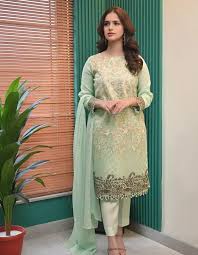
Shalwar Kameez: Timeless Tradition with a Modern Twist
The shalwar kameez, a traditional outfit originating from the Indian subcontinent, stands as a testament to cultural heritage and evolving fashion. Worn by both men and women, this versatile attire has transcended regional boundaries, becoming a beloved garment across South Asia and beyond. This article delves into the history, components, variations, and contemporary significance of the shalwar kameez, highlighting its enduring appeal.
Historical Roots
The shalwar kameez has deep historical roots, with its origins tracing back to the Mughal era in the 16th century. The Mughals, who brought with them Persian influences, popularized this ensemble in the Indian subcontinent. The name itself is derived from Persian, with “shalwar” referring to the loose trousers and “kameez” to the long tunic. Over centuries, the outfit has been adapted and embraced by various cultures within the region, reflecting a blend of tradition and modernity.
Components of Shalwar Kameez
The classic shalwar kameez consists of three main components: the shalwar, the kameez, and the dupatta.
- Shalwar: These are loose-fitting trousers that taper at the ankles. They offer comfort and flexibility, making them suitable for daily wear as well as special occasions. Shalwars can be plain or decorated with embroidery and other embellishments, depending on the intended use.
- Kameez: The kameez is a long tunic that typically reaches the knees or lower. It can be tailored in various styles, from simple straight cuts to more elaborate designs with intricate stitching, patterns, and embellishments. The neckline, sleeves, and hem can also vary, offering a wide range of customization.
- Dupatta: This is a long scarf or shawl that complements the shalwar kameez. It is often draped over the shoulders or head, adding an element of grace and modesty. Dupattas can be made from a variety of fabrics, including silk, chiffon, and cotton, and are often adorned with embroidery, sequins, or lace.
Variations and Styles
The shalwar kameez has numerous regional variations, each with unique characteristics that reflect local cultures and preferences.
- Punjabi Shalwar Kameez: Originating from the Punjab region, this style is known for its vibrant colors and heavy embroidery. The kameez is usually shorter, paired with a more flared shalwar called the Patiala shalwar.
- Anarkali: Named after a famous courtesan from the Mughal era, the Anarkali style features a long, flowing kameez that flares out like a gown. It is often worn for formal occasions and is associated with elegance and grace.
- Churidar: Instead of the loose shalwar, this style includes tight-fitting trousers known as churidars. The kameez is usually longer, creating a sleek and elongated silhouette. This style is popular for its sophisticated and flattering look.
- Pathani Suit: Commonly worn by men, especially in Pakistan and Afghanistan, the Pathani suit features a knee-length kameez paired with a loose shalwar. It is a symbol of traditional masculinity and is often worn during festivals and special events.
- Angrakha: This style features an overlapping front panel that ties at the side, reminiscent of ancient Indian royal attire. It is often adorned with intricate embroidery and is favored for its unique and regal appearance.
Contemporary Significance
In contemporary fashion, the shalwar kameez has maintained its popularity due to its adaptability and comfort. Designers have continually reinvented the outfit, blending traditional elements with modern trends. This fusion has resulted in innovative styles that cater to diverse tastes and occasions.
- Designer Shalwar Kameez: High-end designers have embraced the shalwar kameez, creating luxurious versions for weddings and other formal events. These outfits often feature exquisite fabrics, intricate embroidery, and elaborate embellishments, making them stand out as works of art.
- Casual Wear: The shalwar kameez remains a staple for everyday wear due to its comfort and practicality. Cotton and linen versions are especially popular in the hot climates of South Asia, offering a breathable and stylish option for daily use.
- Fusion Fashion: The global fashion industry has seen a rise in fusion styles, where the shalwar kameez is paired with Western elements. This includes pairing the kameez with jeans or trousers, and incorporating modern cuts and patterns. This trend appeals to younger generations who seek to blend tradition with contemporary fashion.
- Cultural Representation: The shalwar kameez is not just a piece of clothing; it is a symbol of cultural identity. It plays a significant role in representing South Asian heritage in international settings, from Bollywood films to global fashion shows. Celebrities and public figures often wear shalwar kameez to showcase their roots and celebrate their culture.
Conclusion
The shalwar kameez is a remarkable garment that has stood the test of time. Its journey from the royal courts of the Mughals to the streets of modern cities illustrates its enduring appeal and versatility. Whether worn for its cultural significance, comfort, or fashion statement, the shalwar kameez continues to be a cherished outfit that beautifully blends tradition with modernity. As it evolves with changing trends, it remains a vibrant and integral part of South Asian culture, symbolizing a rich heritage and a timeless elegance.







